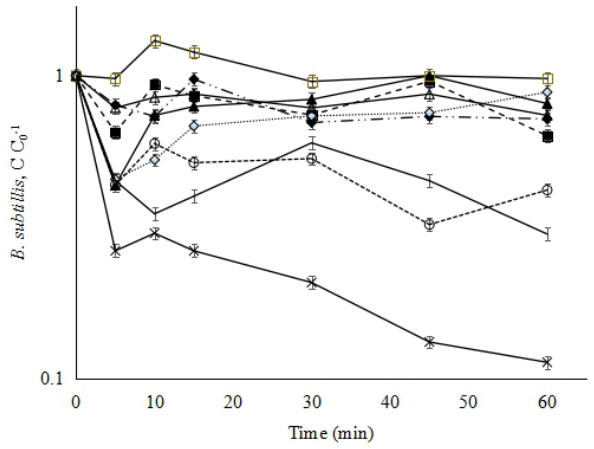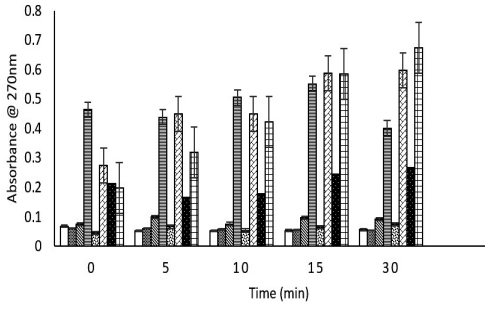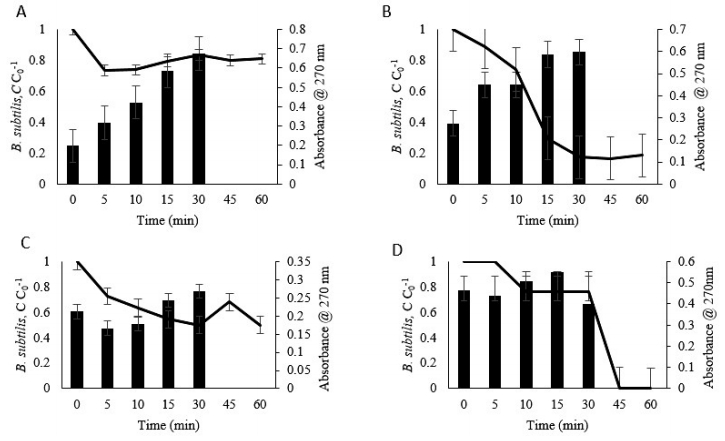1. Introduction
The removal of microbial pathogens in water or food have been attempted by different emerging technologies, like Advanced Oxidation Technologies (AOTs). AOTs have been tested for their ability to inactivate several different pathogens [1,2]. In particular, Fenton and Fenton-like processes are identified as effective alternatives for inactivating highly resistant microorganisms [3,4,5]. Spores of various Bacillus species are metabolically dormant and extremely resistant to a variety of harsh treatments, including heat, radiation, and many toxic chemicals [6] (Table 1). This extreme resistance is the main reason that spores are major causative agents of food spoilage and food-borne disease and why spores of Bacillus anthracis are a potential biological warfare agent. Spore resistance is due to a variety of factors, being spore coat probably the most significant one against oxidant process. The coat is the outer layer of Bacillus species spores and consists primarily of protein. Particularly, the coat of Bacillus subtilis spores includes > 70 different individual proteins, cross-linked in most of the cases [7,8,9]. Most of cross-linked proteins are components of the coat only, although a few coat proteins also have significant roles in coat assembly. The spore coats are organized into four distinct layers: a basement layer closely near to the cell membrane, the inner coat, outer coat and crust [10]. Assembly of the different coat layers depends on one major morphogenetic protein [10,11,12] to generate a semipermeable, generally allowing molecules < 5 kDa pass into interior layers [13] and protective barrier [14]. Despite the precise protecting mechanism is unknown, coat proteins have been suggested containing enzymes (e.g., superoxide dismutase, catalase and CotA laccase), capable to assist in detoxification processes that contribute to spore resistance [13]. The photo-assisted Fenton reaction have been tested in the past for the inactivation of highly resistant microorganisms [4,5] but few is known on the role that spore coat has on the efficiency of this AOT for spore inactivation. The goal of this research is using photo-assisted Fenton reaction to test the effect of different conditions of pH and concentrations of both Fe(Ⅱ) and H2O2 on wild type (wt) and coat mutant spores of Bacillus subtilis. The following issues are of particular interest for our research: (ⅰ) whether the reagent acts in the spore core or on some more external spore layer; and (ⅱ) what spore features are important in protection against this inactivation process.
Table 1. Resistance vegetative and dormant spores of wild type Bacillus subtilis to various treatments *.
| Treatment |
Time, dose or number of freeze drying to kill 90% of the population |
|
vegetative cells |
Dormant spores |
| UV radiation (254nm) (kJm-2) |
36 |
330 |
| Wet heat (90C) (min) |
< 0.1 |
18 |
| Dry heat (120C) (min) |
- |
18 |
| H2O2 (15% at 23C) (min) |
< 0.1 |
22 |
| Freeze drying (number) |
< 1 |
> 20 |
| Manosonication (amplitude mm) |
60 low intensity |
150 high intensity |
| High hydrostatic pressure (MPa) |
100–600 |
100–600 Cyclic treatments |
| Pulsed electric field (kV cm-1) |
9–50 |
Not possible |
| * Partially obtained from [26] and from [1a] |
2. Materials and Methods
2.1. Reagents
Chemicals reagents used in the experiments, FeSO4.7H2O (Baker), H2O2 (50% stabilized, Baker) were ACS grade and used as received without further purification.
Bacillus strains used: The B. subtilis wild-type strain (wt) used was PS533 [15], a derivative of the laboratory 168 strain, which carries plasmid pUB110, which encodes resistance to kanamycin (10 µg mL-1). All other strains used were isogenic with strain PS533 but lacked plasmid pUB110 and were (ⅰ) PS3328 (cotE)
[16], which has the majority of the gene encoding the spore coat morphogenetic protein CotE replaced with a tetracycline resistance (Tcr; 10 µg mL-1) cassette; (ⅱ) PS4149 (gerE)
[16] has the majority of the coding sequence of the gerE gene replaced by a spectinomycin resistance cassette (Spr; 100 µg mL-1) (ⅲ) PS4150 (cotE gerE) [13], which has the cotE mutation from PS3328 and also has the majority of the coding sequence of the gerE gene replaced by a spectinomycin resistance cassette (Spr; 100 µg mL-1).
2.2. Preparation and purification of spores
B. subtilis spores were prepared as described elsewhere in literature [17,18]. Briefly, the fresh culture of B. subtilis in a 2xYT was seeded on 250 mL 2xSG broth. The culture was incubated at 37 oC with mechanical shaking for 5 days, monitoring the sample under the microscope until the cells became spores. At the end of this time period, the culture was centrifuged at 10,000 rpm to collect the spores. The supernatant was discarded and the spores were re-suspended in cold water. The spores were washed and sonicated until no vegetative cells or debris were observed under the microscope. Spores were finally suspended in 0.01 M phosphate buffer (pH 7.0) and the resulting stock had a spore density of 109 spore mL-1. Spore number was counted by cell viability and the stock was refrigerated at 4 ℃ until used for experiments.
2.3. Spore inactivation experiments
All experiments were performed in sterilized distilled-deionized water (DI). Experiments designed to characterize the inactivation kinetics of B. subtilis spores wild strain and mutants with UV radiation were conducted in a bench-scale semi-batch reactor using a UV-A lamp photo reactor made of two low-pressure UV lamps (λmax = 365 nm, 15 W, GE F1578/BLB) with an OF-365AUV (black) Filter from Spectroline1 (cutting wavelength 365 nm) were used as a radiation source. Semi batch reactors consisted on 25 mL glass bakers that contained 10 mL of spore suspension (109 spores) and were exposed to UV-A radiation (total radiation input 1.5 mW cm-2). Radiation intensity in the photo reactor was measured with a pyranometer (Solar light, Mod. PMA2141). During the experiment, the spore suspensions were thoroughly mixed using a conventional stir plate and a magnetic bar [19].
Three different Fe(Ⅱ) concentrations (0.0, 1.0 and 5 mM) were tested using the same initial concentration of hydrogen peroxide (100 mM) for wt and four different concentrations for the spore mutants (0.0, 1.0, 10.0 and 100 mM). For all experiments, the pH of the suspension was adjusted to 3.0 using 0.1 M H2SO4 according the efficiency of previous reports [20a, 24a], then the necessary amount of Fe(Ⅱ) was added to the spore suspension in order to obtain the desired catalyst concentration. The solution was homogeneously mixed for 1 min in the dark and an initial (t0) sample was withdrawn at this moment and analyzed for spore viability. Then hydrogen peroxide was added to the suspension and the reaction mixture was immediately irradiated. The inactivation experiment was considered as started at the precise instant that irradiation was initiated as previously reported [20,21]. In all tests, 100 μL samples were obtained at every 5 min during the first 15 min of reaction time, then every 15 min during the first hour and finally every 30 min for the last hour. Once taken, all samples were diluted up to 107 times using 0.85% sodium chloride solution at pH 7.0. In between each dilution step, the bacterial suspensions were mixed using a vortex to ensure de homogeneity and 10 µL of each dilution was spotted on 2xYT agar. Colonies were visually identified and counted after overnight incubation at 37 oC in a microbiological incubator (Isotemp, Fisher Sci).
2.4. Analytical procedures (DPA analysis)
During spore inactivation process, the DPA released was monitored by measuring the OD270 of the supernatant fluid as reported previously [22]. Briefly, heat-activated spore suspensions (OD600 1.5) were cooled and incubated at 40 ℃ in 25 mM sodium phosphate buffer (pH 7.0). At different times (0, 5, 10, 15, 30, 45, 60 min), aliquots of 1 mL, were centrifuged in a microcentrifuge (13,200 rpm, 2 min), and the spore pellet was washed twice with 1 mL of distilled water (DDW) and suspended in 1 mL of DDW. Each spore suspension was boiled for 30 min, cooled on ice for 5 min, centrifuging in a microcentrifuge (13,200 rpm, 2 min). Then, the DPA amount was determined by mixing 0.8 mL of sample plus 0.2 mL of the developing reagent [C2H3NaO2 (0.05M pH 4.6), Cysteine (1 g/L), FeSO4 (0.68 g/L), (NH4)2SO4 (0.32 g/L)] and measuring the absorbance at 270 nm (OD270)as described previously [22].
3. Results and Discussion
3.1. Wild type spores
Similar to previous experiments [20a] was found that at acid conditions (pH 3) produce better results on mortality rate for wt spores (Figure 1) (experimental data for assays at pH 7 or 9 is found in supplementary material). This result can be explained by the improved solubility of iron and being available to generate more hydroxyl radicals than in other pH values as seen in other previous work using the same system to inactivate helminthes eggs [20a] and this low pH no affect the hydroxyl radical production as stated by Zepp et al, in 1992, where they reported that hydroxyl radicals are well produced at pH ranging from 3 to 8 using Fe(Ⅱ) or Fe(Ⅲ) plus H2O2, and can be used this reaction to treat contaminated water (Zepp, et al 25a). It was interesting to see that the photo-assisted Fenton reaction with the mix of the three factors (Fe(Ⅱ), H2O2 and UV radiation) showed better efficiency to inactivate spores than just the combination of only two components of them. It is known that Fe(Ⅱ) with O2 and UV are capable to generate hydroxyl radicals or other reactive oxygen species (ROS)
[22a]. The wt spores are very resistant to H2O2 due to spore coats as previously by [20a] in similar way reported by chlorine reagents as stablish by Young and Setlow [23] being important the integrity of the inner membrane of the spore to can inactivate the spores when it is compromised. In our assays of spore inactivation, the B. subtilis wt spores (533) were inactivated by the mix of Fe(Ⅱ) 5 mM, UV radiation (365 nm) and H2O2 100 mM (maximum concentration) to generate 1 log (90 %) inactivation in 60 minutes (Figure 1). The spore inactivation using photo-assisted Fenton is in agreement with previous results reported by Bandala et al. [20] and Corona-Vasquez et al. [24] where they also mention this reaction produce high amount of ROS when pH is acid [14].
3.2. Spore mutants
Contrary to wt spores, spore mutants lacking ger E gene (4149), cot E gene (3328) and double mutant ger E/cot E-(4150) were more sensitive to lower concentrations of the photo-assisted Fenton reagents (1 mM Fe(Ⅱ) and H2O2, and UV radiation) (Figure 2). The sensitivity of the mutants is due to lacking spore coat as stablish previously by Young and Setlow [23]. This results means that spore coat helps to protect spores against many chemical agents as previously informed [25]. Indeed, B. subtilis spores with defective coats are 10-to 100-fold times more sensitive to many oxidizing agents than intact spores [26,30]. It has been suggested that the oxidizing agents used to inactivate spores cause damage to its outer layers and, perhaps, the cell membrane. However, the precise nature of the inner membrane damage caused by oxidants is not well known, although it has been demonstrated that it is not related with the oxidation of unsaturated fatty acids at least in wt spores [26]. However, the lack of spore coats, permit oxidants to easier reach the inner membrane, oxidizing the fatty acids. This hypothesis must be tested in future experiments to establish this assumption [31,32]. The cotEmutant spores are shown to be more sensitive than gerEmutant spores. Because Cot E protein is early deposited during coat spore formation and later is need for the proper Cot C and Cot X deposition which those are dependent to ger E transcription [25]. Then, a cotE mutant will produce a defective spore coat layer deposition generating more sensitive spores to oxidizing reagents. Nevertheless, both strains with single mutations were inactivated at a similar rate but using 5 to 100 times less concentrations of Fe(Ⅱ) and H2O2, respectively, compared with wt spores (Figure 2). Though, spores lacking both gerE and cotE genes were inactivated faster than the single mutation at the same conditions, giving 5 logs (99.9999%) inactivation in 10 minutes demonstrating that the main resistance to ROS are the spore coats as previously reported [2,4,20] and the maximum rate of inactivation is shown during the first 10 minutes of reaction. This effect can be, because the maximum amount of ROS are produced during this time having the maximum oxidizing power and later a constant production of ROS at a constant rate which go in parallel as the spore inactivation process.
As mentioned before, the damage to the spore's inner membrane permeability barrier is a likely mechanism of inactivation by a number of oxidizing agents [23,27,28], all treated spores were tested to find a likely damage in their inner membrane by this process. Previous reports, use the of Dipicolinic Acid (DPA) as indicator of damage to the spore inner membrane when this compound is release, a compound present in high levels chelated with divalent cations in the spore core and whose loss accompanies spore inactivation by wet heat [29,32,34] or starting the spore germination. When DPA was analyzed during the photo-assisted Fenton reaction using any spore mutant or wt (Figure 3), the DPA was not detected (<10%) from spores inactivated by any of the treatments tested except when these spore were only treated with H2O2100 mM. The absence of DPA in the most of the experiments can be due to the direct oxidation of this DPA by the generated ROS in Fenton reaction, but we have not an evidence of this, so further analysis is needed. In other hand, we observed that in the treatment with H2O2 100 mM, the DPA release was constant across the time in wt without inactivation as reported previously [26]. However, the question rising here is how is the spore viability and the DPA release, this analysis is showed in Figure 4. In this figure can be noted that cotE mutant spores showed DPA release similar to wt but the percent of surviving cells decay during the time jointly with DPA release displaying sensitivity to H2O2 by the coat defect. For gerE spore mutant, the DPA release start after five minutes of treatment, together with a reduction of the viability of these spores at the same time. However, as can see, this ger E mutant is less sensitive than the cotE spores, because gerE has more coats layers than cotE [13]. The double spore mutant (gerE/cotE) shows a fast DPA release just adding the H2O2 This DPA amount, looks constant during the treatment time and these spores are completely inactivated at 45 minutes. This results seems to be clearly because the spore coat layers are so defective that allow the action of H2O2 to damage the inner membrane faster than the other strains meaning that the spore coat plays an important role in protection against oxidants. The sensitivity of these spore mutants can used for further analysis to demonstrate the oxidants effect on fatty acids and clarify the mechanisms of inner membrane damage.
The thick proteinaceous coat of the spore protects the inner layers against many chemicals [23] although the coat apparently plays no role in spore resistance to other chemicals including acid, alkali and ethanol, and provides only a small component of spore resistance to hydrogen peroxide in wt spores [23,26]. Treatment with photo-assisted Fenton reaction clearly affects the spore coat as the treatment oxidize this structure through the time, and spore resistance to photo-assisted Fenton reaction is dependent on the presence of an intact spore coat as shown by the high resistance in wt spores or the high sensitivity of cotE and gerE spores or the double mutant. The sensitivity of the mutants can be also due to a reduction on the hydrophobicity of the spores or presenting a higher pore size diameter on the coat structure increasing the ROS permeability reaching the inner membrane faster. So, the photo-assisted Fenton reaction inactivating process seems to be similar to the mechanism whereby spores are inactivated by other oxidizing agents, including chlorine dioxide, hypochlorite, Sterilox® and peroxynitrite where the inner permeability membrane of the spore is damage [23,27,28,33].
4. Conclusions
Spores of various Bacillus species are extremely resistant to a variety of severe treatments, including heat, radiation, and different toxic chemicals. This resistance is undesirable because can cause food spoilage and food-borne diseases or, in some cases, this property can be used for spores with potential biological warfare agent like Bacillus anthracis. In this work we demonstrated outer coat as a very significant structure in spore resistance to oxidizing agents and we have showed that any defect on the layers conforming the coat, reduce its resistance. Also, the photo-assisted Fenton reaction was showed to be an effective technology to inactivate wt and core mutant spores within few minutes using Fe(Ⅱ) combined with H2O2 and UV radiation (365 nm).
Acknowledgements
L.C. Huesca grateful thanks to CONACyT and Universidad de Las Americas, Puebla for providing her with a scholarship for pursuing doctoral studies.
Conflict of interest
No conflict of interest declared.









 DownLoad:
DownLoad: 




























